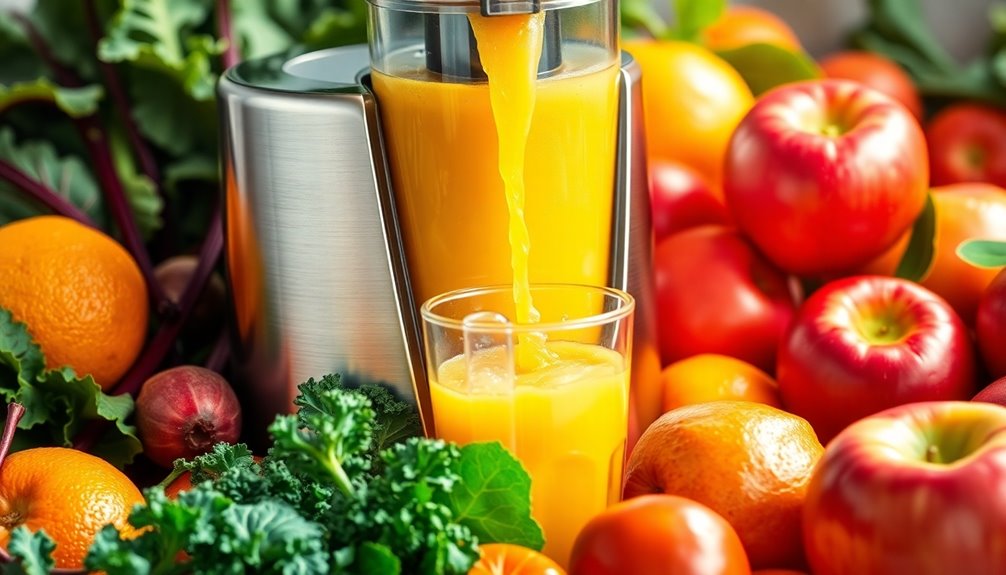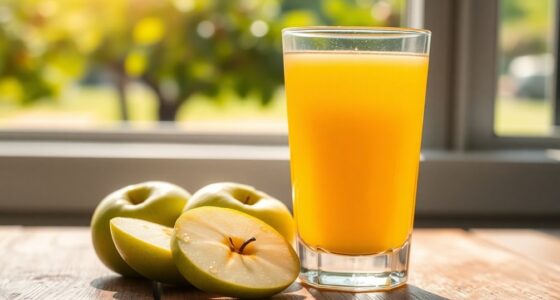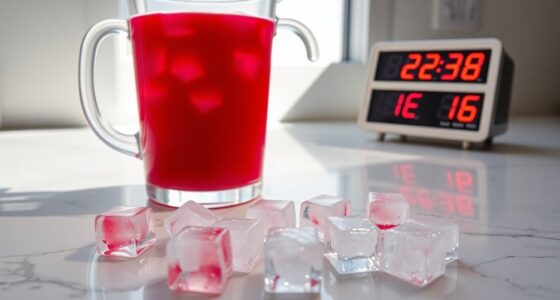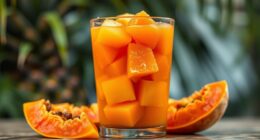To make cold-pressed juice, start by selecting fresh, organic fruits and vegetables. Aim for 80-90% veggies like kale and carrots, and 10-20% fruits for sweetness. Wash, chop, and feed them into a masticating juicer. This method retains more nutrients and enhances flavor. Store any leftover juice in an airtight glass container in the fridge, and enjoy it within 3-5 days for the best health benefits. There's more to discover about the juicing process and techniques!
Key Takeaways
- Choose fresh, organic fruits and vegetables, focusing on 80-90% vegetables and 10-20% fruits for sweetness.
- Wash, chop, and prepare produce into manageable pieces for your masticating juicer.
- Feed the prepared ingredients into the juicer, allowing it to extract juice while separating solids for a smooth texture.
- Consume cold-pressed juice immediately for optimal freshness, or store it in airtight glass containers in the fridge.
- Plan your juicing sessions to maximize yield, as different produce has varying juice yields.
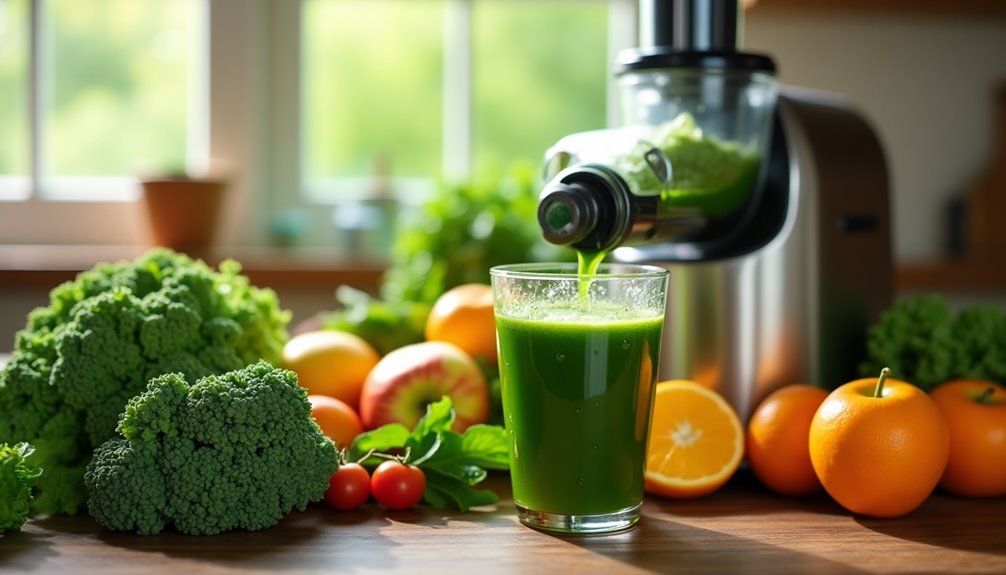
If you’re looking to boost your health, cold-pressed juice might be just what you need. This juice isn’t just delicious; it’s packed with vitamins, minerals, and antioxidants that traditional juicing methods often fail to preserve. The secret lies in the masticating juicer, which crushes fruits and vegetables without producing heat. This gentle process ensures that the nutrients remain intact, giving you a more nutritious beverage. Moreover, cold-pressed juice can be a refreshing and revitalizing option, especially when you’re feeling under the weather. Many people consider it the best juice for cold recovery, as it helps to hydrate and nourish the body with essential nutrients. Incorporating a variety of fruits and vegetables in your cold-pressed juice can also provide a spectrum of benefits, making it a powerful ally in your quest for better health.
When you start making cold-pressed juice, the quality of your produce is crucial. Choose fresh, organic fruits and vegetables whenever possible. Aim for a mix of 80-90% vegetables like kale, spinach, and carrots, and 10-20% fruits such as apples or oranges. This combination balances nutrition and sweetness while helping to avoid those pesky blood sugar spikes. Remember, the goal is to enjoy delicious juice that nourishes your body, so a thoughtful selection of ingredients will make all the difference.
The juicing process itself is straightforward. First, wash and prepare your fruits and vegetables. Make sure to chop them into manageable pieces for your masticating juicer. Some produce, like root vegetables, yields more juice than others. For instance, you can expect about a cup of juice from a pound of carrots, but leafy greens might need up to two pounds to produce the same amount. Understanding these yield differences helps you plan your juicing sessions effectively.
Once your ingredients are prepped, it's time to start juicing. Feed the fruits and vegetables into your masticating juicer, which will grind them down and extract the juice while separating the skins, seeds, and solids. This process not only results in a smoother texture but also enhances the overall flavor of the juice. You'll be amazed at how vibrant and refreshing cold-pressed juice can be!
After you've extracted your delicious juice, it's best to consume it immediately for optimal freshness. However, if you need to save some for later, you can store it in airtight glass containers in the refrigerator. The shelf life of cold-pressed juice is typically 3-5 days, so be sure to enjoy it within that timeframe to reap all the health benefits.
Making cold-pressed juice at home can be a fun and rewarding experience. Not only do you get to experiment with different combinations of fruits and vegetables, but you also have control over what goes into your juice. By following these steps and understanding the juicing process, you'll be on your way to creating a healthier lifestyle with every delicious sip.
Frequently Asked Questions
How to Make a Cold Press Juice?
To make a cold-pressed juice, start by gathering fresh, organic fruits and vegetables.
You'll want to use a masticating juicer, as it preserves more nutrients.
Wash and prepare your produce, cutting larger items into smaller pieces.
Feed the ingredients into the juicer, alternating between softer and harder items for better extraction.
Once your juice is ready, store it in an airtight glass container in the fridge and drink it within 24-48 hours for the best freshness.
Is It OK to Drink Cold-Pressed Juice Everyday?
In the garden of health, sipping cold-pressed juice daily can be a refreshing choice.
You're treating your body to a burst of vitamins and antioxidants, but moderation is key.
Think about 8-16 ounces a day, with a veggie twist to keep things balanced.
This way, you'll avoid sugar spikes and boost hydration.
Just listen to your body, and if you have concerns, don't hesitate to chat with a healthcare professional.
How to Cold Press Juice Without a Machine?
To cold press juice without a machine, start by chopping your fruits and veggies into small pieces.
Blend them with some water until you get a smooth mixture.
Next, strain the blend using cheesecloth or clean tights to separate the juice from the pulp.
Store your fresh juice in an airtight glass container in the fridge and aim to drink it within 24-48 hours for the best taste and nutrients.
Enjoy experimenting with flavors!
What Is the 80 20 Rule in Juicing?
The 80/20 rule in juicing means you should aim for 80% vegetables and 20% fruits in your juice. This balance helps you maximize nutrients while keeping sugar levels in check.
By prioritizing veggies like leafy greens, cucumbers, and celery, you boost hydration and essential vitamins. Adding fruits like apples or berries in moderation enhances flavor without overpowering the nutritional benefits.
Following this rule can lead to healthier, more satisfying juices overall.
Conclusion
So, after all that effort to make your own cold pressed juice, you might find it ironic that the real magic lies not just in the ingredients but in the simplicity of it all. You could've just bought a bottle at the store, right? But there's something uniquely satisfying about pressing those fruits and veggies yourself. You've not only created something fresh, but you've also become part of the juice-making elite—who knew juicing could make you feel so fancy?
Cindy thoroughly researches juicing trends, techniques, and recipes to provide readers with practical advice and inspiration. Her writing style is accessible, engaging, and designed to make complex concepts easy to understand. Cindy’s dedication to promoting the advantages of juicing shines through her work, empowering readers to make positive changes in their lives through the simple act of juicing.

